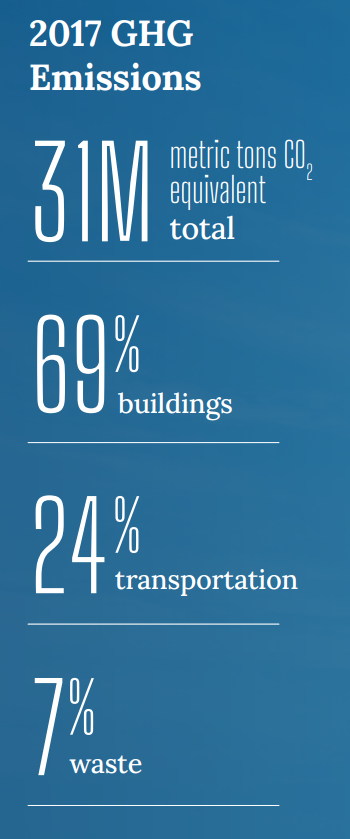Electrify Chicago
An independent tool for viewing City of Chicago building data
According to the
2022 Chicago Climate Action Plan,
69% of Chicago's emissions come from buildings, making
building emissions our biggest challenge and our biggest opportunity as a city
to tackle climate change. At Electrify Chicago, we showcase building performance using
publicly available data supplemented by community-submitted photographs and building
owners.
Start by looking at Chicago's buildings with the highest greenhouse gas intensity i.e. emissions per square foot. Large, efficient, buildings can perform much better than very inefficient small buildings on this metric.
New Article
📰 $30 Million In Missed Fines
The City Of Chicago failed to collect $30 million in potential fines from the building benchmarking ordinance, reducing transparency and accountability.
Legislative update! 🎉
As of late January 2024, legislation is being introduced to require new use more efficient forms of water and space heating, via the Clean And Affordable Buildings Ordinance (CABO), which will reduce the number of highly polluting and inefficient buildings that end up on this site.
If you're in Chicago,
write to your alderman to support the CABO!
Chicago Buildings by Greenhouse Gas Intensity
Note: Data includes large Chicago buildings with data from 2022, unless explicitly stated otherwise.
Note: This data only includes buildings whose emissions are reported
under the
Chicago Energy Benchmarking Ordinance. According to the City “As of 2016,
this list includes all commercial, institutional, and residential buildings larger than
50,000 square feet.” This dataset is also then filtered to only buildings with
reported emissions > 1,000 metric tons CO2 equivalent.
The latest year of data is from 2022, but we update the site regularly when new data is available, and some buildings may have failed to report that year, and only have older data available.
| Property Name / address | Primary Property Type |
Greenhouse Gas Intensity (kg CO2 eq./sqft) |
Total Greenhouse Emissions (metric tons CO2 eq.) |
|---|---|---|---|
|
Astoria Tower
8 E 9th St
| Multifamily Housing | 5.1 kg/sqft
Lowest 26%
| 2,071 tons
Highest 22%
|
|
4901 4913 S DREXEL BLVD
4901 4913 S DREXEL BLVD
| Multifamily Housing | 5.1 kg/sqft
Lowest 26%
| 439 tons
Lowest 20%
|
|
865 N LARRABEE ST
865 N LARRABEE ST
| Multifamily Housing | 5.1 kg/sqft
Lowest 26%
| 407 tons
Lowest 17%
|
|
The Legacy HB at Clarendon Park
🕰️
4520 N CLARENDON AVE
| Multifamily Housing | 5.1 kg/sqft | 404 tons |
|
1350 1358 N ASTOR ST
1350 1358 N ASTOR ST
| Multifamily Housing | 5.1 kg/sqft
Lowest 26%
| 364 tons
Lowest 14%
|
|
415 421 W ALDINE AVE
415 421 W ALDINE AVE
| Multifamily Housing | 5.1 kg/sqft
Lowest 26%
| 710 tons
Lowest 41%
|
|
426 W SURF ST
426 W SURF ST
| Multifamily Housing | 5.1 kg/sqft
Lowest 26%
| 455 tons
Lowest 22%
|
|
900 W FULLERTON AVE
900 W FULLERTON AVE
| Multifamily Housing | 5.1 kg/sqft
Lowest 26%
| 267 tons
Lowest 6%
|
|
George W Dunne Cook County Office Building
69 W Washington St
| Office | 5.1 kg/sqft
Lowest 26%
| 4,156 tons
Highest 9%
|
|
221 E 121ST PL
221 E 121ST PL
| Multifamily Housing | 5.1 kg/sqft
Lowest 26%
| 781 tons
Lowest 45%
|
|
Lane Tech HS -CPS
(CPS)
2501 W Addison St
| K-12 School | 5.1 kg/sqft
Lowest 26%
| 3,633 tons
Highest 10%
|
|
701 709 W BROMPTON AVE
701 709 W BROMPTON AVE
| Multifamily Housing | 5.1 kg/sqft
Lowest 26%
| 273 tons
Lowest 6%
|
|
Marist HS
4200 W 115th St
| K-12 School | 5.1 kg/sqft
Lowest 26%
| 1,245 tons
Highest 38%
|
|
1 S Leavitt Street
(CHA)
1 S Leavitt Street
| Multifamily Housing | 5.0 kg/sqft
Lowest 25%
| 281 tons
Lowest 7%
|
|
McCRORY SENIOR APARTMENTS
1659 W Washington Blvd
| Multifamily Housing | 5.0 kg/sqft
Lowest 25%
| 312 tons
Lowest 9%
|
Data Source:
Chicago Energy Benchmarking Data
